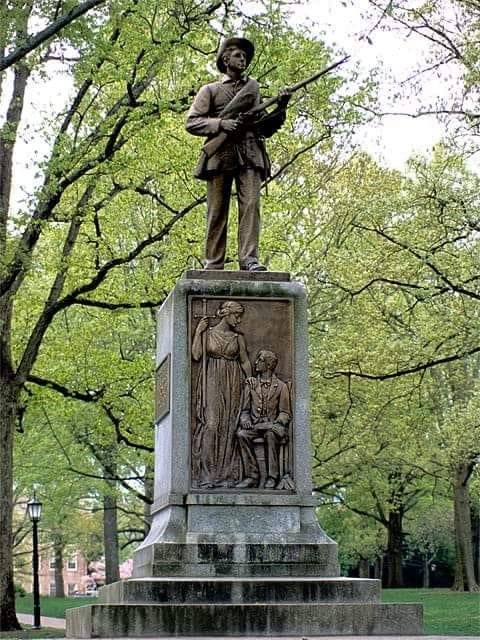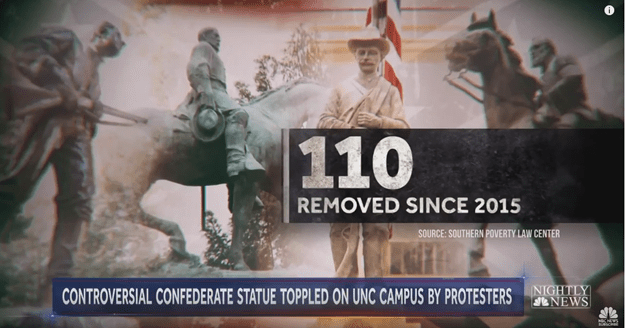Lately, a lot of emotion has been spent over Confederate monuments in the Tar Heel state.
 Silent Sam, the statue on the campus of the University of North Carolina, Chapel Hill, was gleefully pulled from its pedestal by a mob, August 20th. Former alumni, as well as citizens across the state, were outraged at the lawless act and the justifications given for it.
Silent Sam, the statue on the campus of the University of North Carolina, Chapel Hill, was gleefully pulled from its pedestal by a mob, August 20th. Former alumni, as well as citizens across the state, were outraged at the lawless act and the justifications given for it.
Two days later, August 23rd, the North Carolina Historical Commission rejected Governor Roy Cooper’s request to relocate three Confederate monuments on state Capitol grounds. The Commission opted instead to provide contextualization signage and raise funds for constructing and erecting African-American monuments.
Contextualization creates angst for many, while others rail against the Commission’s decision to leave the monuments standing. The situation remains a hotbed of passion on both sides.
I have written on this subject a number of times. I cannot say that everyone who is a part of the organization I represent, the Christian Action League, believes as I do on the topic. Nevertheless, I speak because I believe the matter is one of significant import to our state, country, and Western Civilization.
To understand history, it’s important that one hears all sides of the story. When memorials such as Confederate monuments are pulled down, it’s because only one narrative is being allowed.
Critics of Silent Sam said that the monument sends a message of racism and White Supremacy. They argue it was erected during a period in history when whites wanted to show that they still ruled the south.
Their proof? Julian Carr’s speech at the unveiling with its egregious and wrongheaded remarks about what the Confederate soldier meant to the Anglo Saxon race and how he, Carr, personally horsewhipped a black woman after insulting a Southern white lady. Also cited as evidence are the United Daughters of the Confederacy, who spearheaded and funded the monument. Some contend the UDC is a white supremacist organization, an accusation the UDC denies.
Critics of Silent Sam also argue the Confederate soldier was a traitor to his country and a defender of slavery. Memorials to Confederates glorify treason and the subjugation of the black race, they say.
I’m certain some sophisticate will charge that I’m just a backward preacher from the South with a misinformed and misguided allegiance to a terrible group of people. But I can’t agree the issue is that simple.
White Supremacy?
Thomas J. Crane, an attorney who represents individuals in employment actions and has appeared in both state and federal court, says the charges of racism against statues like Silent Sam and other Confederate memorials wouldn’t succeed in a court of law.
In a most intriguing article titled, Confederate Monuments and Racism, Crane writes:
“I represent victims of discrimination. Like historians, I am in the business of accusing persons or entities of discrimination. But, if I tried to accuse a person or statue of racist bias based solely on speeches by third parties, I would likely be sanctioned by the court for filing a frivolous lawsuit…There are several alternative explanations for why these statues were erected.
“The challenge regarding the Confederate monuments is there is always a legitimate alternative explanation. The United Daughters of the Confederacy was founded expressly to commemorate the deceased Confederate veteran. The Confederate States of America was not the United States of America. That means there was no government effort to mark the passing of these hundreds of thousands of veterans. If the UDC or some organization like the UDC did not raise the funds for these monuments, it would not be done…
“Certainly in most communities, the Daughters were part of the white power structure. But, being part of the dominant white society does not mean those Daughters necessarily sought to support Jim Crow laws when they erected those monuments.”
 Crane is right. There are many other valid reasons for Confederate monuments, which received broad support in the day of their placing.
Crane is right. There are many other valid reasons for Confederate monuments, which received broad support in the day of their placing.
History shows Confederate veterans were dying at the time and family members wanted to memorialize their fathers, brothers, and husbands before their passing. Others felt that their loved ones who suffered, sacrificed, and died in that great conflict deserved better recognition and more prominence than what they received in a cemetery for the Confederate dead. Reconstruction had also ended, and there was more money available for building and raising these memorials. Moreover, such monuments were seen as reunification symbols, where the Confederate heritage was brought into the larger American context, acknowledged, respected, and tolerated.
One might ask, if the sole purpose of these monuments was to lionize White Supremacy and slavery, why wasn’t this stated on the monuments? No such pattern exists.
In the case of Silent Sam, the plaque on the memorial simply read: “To the sons of the University who entered the war of 1861-65 in answer to the call of their country and whose lives taught the lesson of their great commander that duty is the sublimest word in the English language.”
Confederates Soldiers Were Traitors?
In my estimation, there is no basis for the indictment that Confederate soldiers were traitors. It’s true the war started when Southerners fired on Fort Sumter in South Carolina, but who provoked the conflict is still in dispute by historians.
Lincoln sent a ship to re-provision Fort Sumter, which was a federal fort in Charleston. South Carolina had already seceded from the Union, along with six other states. Certainly, if secession had any meaning, the state couldn’t permit a foreign power to maintain a military fort on its own soil. When negotiations broke down between President Lincoln’s administration and President Jefferson Davis’ administration for the transfer of the fort to South Carolina, Confederates fired on Fort Sumter, which resulted in Union forces surrendering. Although there were no casualties, Lincoln sent 75,000 troops into the “rebel” states, which resulted in four additional Southern states, including North Carolina, seceding from the Union.
 The Southern states also seceded from the Union based on the Tenth Amendment to the U.S. Constitution. The right for states to legally secede was widely accepted. Even Alexis de Tocqueville, the French political thinker and historian, who visited America to study its system of government, said the Union “was formed by the voluntary agreement of the states; and these, in uniting together, have not forfeited their nationality, nor have they been reduced to the condition of one and the same people. If one of the states chose to withdraw its name from the contract, it would be difficult to disprove its right to do so.”
The Southern states also seceded from the Union based on the Tenth Amendment to the U.S. Constitution. The right for states to legally secede was widely accepted. Even Alexis de Tocqueville, the French political thinker and historian, who visited America to study its system of government, said the Union “was formed by the voluntary agreement of the states; and these, in uniting together, have not forfeited their nationality, nor have they been reduced to the condition of one and the same people. If one of the states chose to withdraw its name from the contract, it would be difficult to disprove its right to do so.”
Again, traitors? How can Confederate soldiers be traitors when the states in which they resided had seceded from the Union, as was their Constitutional right, and formed a new country of which they were citizens?
Confederates Soldiers Fought for Slavery?
Neither is it right to contend that Confederate soldiers were all about defending slavery. This is not to say the conflict was never about slavery. Instead, its to argue that the reason they fought was more nuanced.
 Thomas E. Woods, an American historian, who is both a Harvard and Columbia University graduate, correctly argues in, The Politically Incorrect Guide to American History, that “slavery was far from the only issue on Southerner’s minds, particularly since the great majority of Southerners did not even own slaves. For their part, Robert E. Lee and Stonewall Jackson, two of the South’s best-known Generals, described slavery as ‘a moral and political evil.’ Lee had even been an opponent of secession, but fought on the side of Virginia rather than stand by as the federal government engaged upon the mad project of waging war against his state. Recall that Virginia, Tennessee, Arkansas, and North Carolina seceded only after Lincoln had called up 75,000 volunteers to invade the South and prevent its secession. These four states, therefore, certainly did not secede over slavery, but rather over Lincoln’s decision to use military force to suppress Southern independence.”
Thomas E. Woods, an American historian, who is both a Harvard and Columbia University graduate, correctly argues in, The Politically Incorrect Guide to American History, that “slavery was far from the only issue on Southerner’s minds, particularly since the great majority of Southerners did not even own slaves. For their part, Robert E. Lee and Stonewall Jackson, two of the South’s best-known Generals, described slavery as ‘a moral and political evil.’ Lee had even been an opponent of secession, but fought on the side of Virginia rather than stand by as the federal government engaged upon the mad project of waging war against his state. Recall that Virginia, Tennessee, Arkansas, and North Carolina seceded only after Lincoln had called up 75,000 volunteers to invade the South and prevent its secession. These four states, therefore, certainly did not secede over slavery, but rather over Lincoln’s decision to use military force to suppress Southern independence.”
Additionally, Civil War historian James McPherson’s incredible research, consulted a sizeable number of Union and Southern soldiers’ letters and diaries on the way they viewed the war. The results clearly determined that they were concerned about saving the Union, the right of Secession, Constitutionalism, the Founding Fathers, but not slavery.
In other words, Southern politicians might have had slavery on their minds. However, the issue wasn’t a primary concern for Confederate soldiers on the battlefield. They weren’t putting their lives on the line each day, their bodies being torn and broken by cannonballs, bullets, and bayonets, just so they could enslave, whip, or lynch black people. The notion is preposterous.
Instead, they fought primarily for reasons of patriotism. They fought because they believed their homeland had been invaded. They fought for fear of the federal government enslaving them, and preventing their own self-determination. They fought for their independence. They fought for the commercial freedom of the South. They fought because they had lost family members through acts of brutality by the enemy. They fought because an occupying force was often denying their rights. They fought because they didn’t believe they deserved the scourge of their wives eating rats, their children starving, and their property reduced to ashes.
Whether they believed in slavery or not, whether their government was right about it or not, the South was their home, and they would give their lives in defense of it.
Oversimplification and Overreach
Certainly, these affairs were the larger part of the equation. Therefore, making Confederate monuments primarily about White Supremacy, treason, and slavery is gross oversimplification and overreach.
In the same article referenced earlier, Crane contends that “alleged prejudice must be based on more than mere speculation and tenuous inferences.” The case must be proven, and the preponderance of the evidence must reasonably conclude racist intent. The evidence doesn’t show this to be the reason for erecting Confederate monuments. Even racial motivations do not necessarily constitute a racial purpose.
With these assertions in mind, I will conclude with these thoughts.
 True Tolerance Essential
True Tolerance Essential
America is a place of many cultures, many political opinions, and many values. True tolerance, which respects individuals without necessarily approving of everything they believe or espouse, is essential.
As a white man, I may not be able to fully connect with a monument like the National Memorial for Peace and Justice in Alabama, which is dedicated, in part, to the way people of color are often burdened with presumptions of guilt and police violence. Nevertheless, I can reverence and appreciate my fellow Americans. This same deference should go the other way.
To take down memorials placed in honor of deceased people who forewent their health and happiness, forfeited their honor and substance for the ones they loved in a time of war, is to say such people and the ones for whom they spent their affections don’t count. It’s to say their ancestors are evil and beyond the recognition of any noticeable or worthy virtues.
Orwellian Ends
Moreover, pulling down said monuments, more often than not, produces Orwellian ends. If the monuments are taken down, there remains only a one-sided account. There is no way to ponder them and the full significance of their meaning, as well as the lessons they can teach.
Taking down monuments and memorials is a revolutionary tactic of history. Burn the books. Destroy the landmarks. Topple the statues. Flatten the memorials.
 In a quote from George Orwell’s dystopian novel, 1984, we read, “One could not learn history from architecture any more than one could learn it from books. Statues, inscriptions, memorial stones, the names of streets, anything that might throw light on the past had been systematically altered.”
In a quote from George Orwell’s dystopian novel, 1984, we read, “One could not learn history from architecture any more than one could learn it from books. Statues, inscriptions, memorial stones, the names of streets, anything that might throw light on the past had been systematically altered.”
Here’s another: “Every record has been destroyed or falsified, every book rewritten, every picture has been repainted, every statue and street building has been renamed, every date has been altered, and the process is continuing day by day and minute by minute. History has stopped, nothing exist except an endless present in which the Party is always right.”
Isn’t this what we are witnessing? – an intentional and imposed ignorance.
It’s an appropriate question to ask where this will end. What else besides Confederate monuments is next to be removed or hidden away in some rather obscure place? Will it be statues of Washington and Jefferson? What about the U.S. Flag? Could it be the Christian Cross on steeples and buildings? Might it be any reminders of America’s heritage or Western Civilization that causes offense, makes people feel unwelcome, or hurts their feelings?
It isn’t spurious to question whether the goal or the outcome will be to lose ourselves in the mass mind and the mass will.
While there was cheering at the fall of Silent Sam at UNC, the lawless action of the mob which perpetrated the crime signals a time of future mourning. A time when intolerance is supreme, lack of knowledge predominant, and uniformity enforced.
Yes, this matter is of considerable import to our state, nation, and Western Civilization.
Written by Rev. Mark Creech for Christian Action League ~ August 24, 2018
 FAIR USE NOTICE: This site contains copyrighted material the use of which has not always been specifically authorized by the copyright owner. We are making such material available in our efforts to advance understanding of environmental, political, human rights, economic, democracy, scientific, and social justice issues, etc. We believe this constitutes a ‘fair use’ of any such copyrighted material as provided for in section 107 of the US Copyright Law. In accordance with Title 17 U. S. C. Section 107, the material on this site is distributed without profit to those who have expressed a prior interest in receiving the included information for research and educational purposes. For more information go to: http://www.law.cornell.edu/uscode/17/107.shtml
FAIR USE NOTICE: This site contains copyrighted material the use of which has not always been specifically authorized by the copyright owner. We are making such material available in our efforts to advance understanding of environmental, political, human rights, economic, democracy, scientific, and social justice issues, etc. We believe this constitutes a ‘fair use’ of any such copyrighted material as provided for in section 107 of the US Copyright Law. In accordance with Title 17 U. S. C. Section 107, the material on this site is distributed without profit to those who have expressed a prior interest in receiving the included information for research and educational purposes. For more information go to: http://www.law.cornell.edu/uscode/17/107.shtml

That statue was erected to honor the young men that went to that school and left to give their lives to protect their homes,family and property from the northern invasion. Most of the Southern men that died never owned a slave they were dirt poor farmers that couldn’t afford a slave. If you wanna take down a statue of the biggest white supremacist this country has seen go take down ol unhonest Abe lincoln and leave the Confederate Memorials alone. Abraham Lincoln never even mentioned freeing the slaves til 1863, half way through the war, and he only did then to try to gain moral ground with England so that England wouldn’t come help the Confederacy. He knew England depended on the imports that came from the South so it would make economic sense that England would be more apt to help the Confederacy.
Ulysses s Grant still owned slaves upon he return from the war. The war of northern aggression was not over slavery. Those men that died in them fields were doing nothing more than defending their selves, possessions and for states rights to govern themselves. Why don’t you look it up and see how many men of color voluntary fought for the Confederacy. They went out and fought and died, very honorably, for the South. The union army didn’t allow free men of color join their army til late in the war and that was only because they needed body’s out there. So with all that being said, what about any of that leads you to believe that statue represented racism and slavery. Slavery was a horrible thing I’m by no means down playing the institution of slavery, what I am saying is ALL of America at that time embraced the institution of slavery and north still had slaves in bondage at the conclusion of the War of Northern Aggression. I’m not saying in all cases it was like this, but a good number of them chose to stay with their prior “owner” and took on their last name in many cases. The South was not the way that it’s portrayed to have been. I’m sure there were slave owners that beat their slaves or mistreated them and I’m just as sure that it happened in the north just as much if not more. America did embrace slavery for what almost 200 years before the war even started. So again how is it that the entire Confederacy were white supremacist fighting for nothing more than the right to keep their slaves ~ Chris P-nut Gabbard on Facebook